5 Causes of Tire Cupping (and How to Prevent It)
As any car owner knows, tires are quite expensive, often in the neighborhood of $1,000 per set. Preserving tire life saves money, but irregular wear like cupping reduces mileage.
But what exactly is tire cupping, what causes it, and is there any real danger to driving on cupped tires?
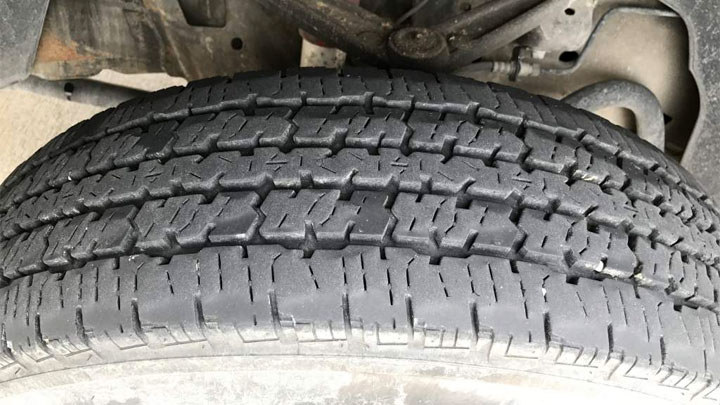
See Also: 16 Best Tire Brands For the Money
What is Tire Cupping?
Tire cupping is a form of irregular tire wear that manifests in the form of scalloped or dished tread. In the majority of cases, this cupping will not be contained to a single area of tread, but rather continue across the outer circumference of the tire as a whole.
Cupping is among the most common forms of irregular tire wear, occurring on thousands of vehicles annually. From cars to motorcycles, almost all vehicles are prone to irregular tire wear.
The single most prominent contributing factor to this form of irregular tire wear is mechanical fatigue. However, pinpointing the exact source of this mechanical fatigue can often be somewhat more complex.
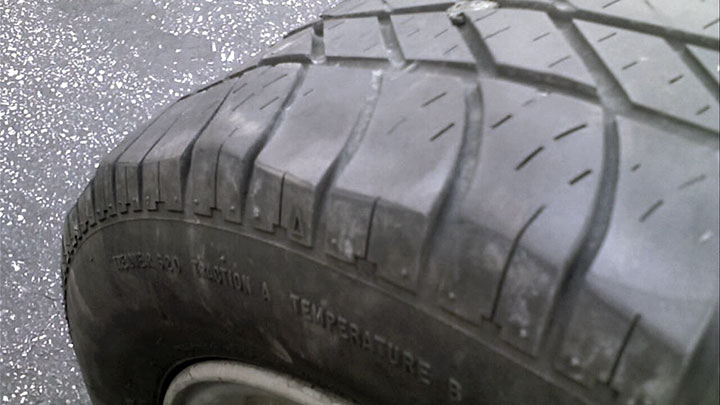
Unfortunately, the matter of tire cupping is not easily resolved without mechanical intervention, and in many cases, the true damage has already been done. As a result, a substantial number of otherwise suitable tires are removed from service on an annual basis, due to considerable cupping.
Related: What is Dry Rot In Tires?
What Causes Cupping on Tires?
Tire cupping can be caused by a number of underlying conditions, each of which varies in frequency and severity. Recognizing and understanding each of these root causes is paramount when attempting to remedy tread-related issues of this nature.
The following are several of the most common causes of tire cupping.
#1 – Failure to Regularly Rotate Tires

Tires simply do not wear evenly, and as a result, regular tire rotations (ideally every 6,000 miles or six months) are recommended for most vehicles. When this recommendation is not followed, uneven tread wear, cupping, scalloping, and bald spots can be the result.
While tire rotations are important for every vehicle, trucks and cargo vans are especially prone to cupping when a tire rotation schedule is not followed.
Typically, tire chains like Les Schwab and Discount Tire will offer free tire rotations if you purchased your tires through them. Also, many oil change places (and some dealerships) offer free tire rotation with the purchase of an oil change. There’s really no excuse to not rotate your tires.
#2 – Worn or Damaged Suspension Components
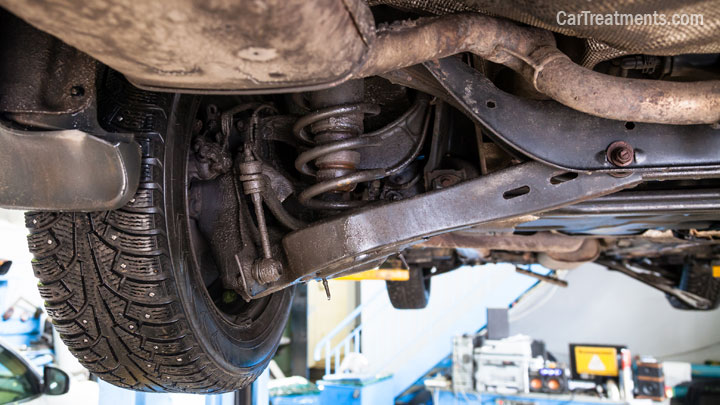
One of the most common causes of tire cupping relates to severely worn suspension components.
A vehicle’s shocks and struts dampen vibration from the road and prevent our vehicle’s tires from bouncing up and down erratically upon the surface of the roadway. When any of these components become compromised, tread cupping often occurs shortly thereafter.
#3 – Out of Balance Condition

All wheels and tires possess natural heavy spots, which must be balanced out to provide a smooth ride. Throughout a tire’s lifespan, this process must also be repeated from time to time, thereby enhancing a tire’s stability.
However, if a tire is allowed to get severely out of balance, irregular wear often results. In many cases, as an out of balance tire skips across a roadway, cupping-type wear results.
#4 – Tires Out of Round

In certain instances, a tire will exhibit excessive runout. This essentially means that a tire is out of round, causing a noticeable hop or wobble when traveling down the road.
This generally occurs when a tire has shifted a structural belt, or when a tire is of sub-par construction. In most cases, these irregularities only become more severe with the passage of time, eventually leading to substantial cupping.
#5 – Poor Alignment
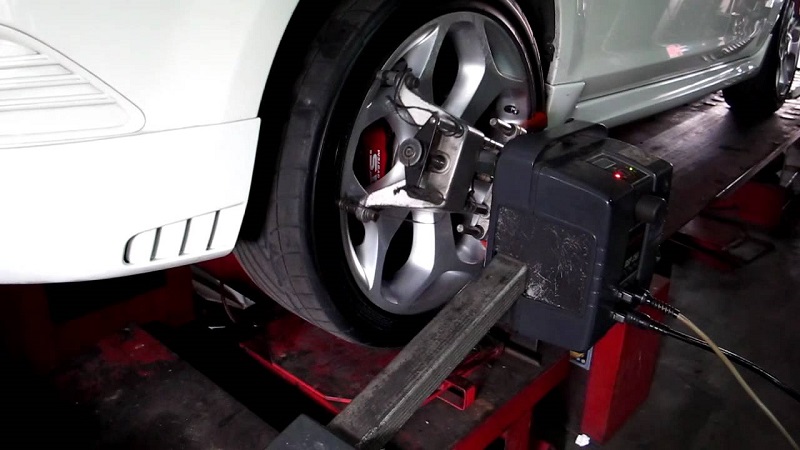
An improperly aligned front end can also be the source of significant tire cupping. The standard vehicle’s front steering and suspension feature three individual adjustments (caster, camber, and toe), any of which can present issues if out of specification.
In the most severe of cases, irregular tire wear is almost guaranteed to result.
Is Tire Cupping Dangerous?
Driving on severely cupped tires can, in fact, be quite dangerous. This is due to the fact that cupped tread does not adhere to the road in the same manner as tread exhibiting normal wear. Simply put, tread-to-pavement contact is reduced when cupping occurs, thereby compromising vehicle traction.
This traction loss is no different than that which results from other types of irregular tire wear, such as inside tire wear or outside tire wear, and is most evident when driving in slick conditions. This presents a substantial hazard, which can ultimately result in an increased likelihood of an accident.
In any case, severely cupped tires should be taken out of service and discarded as soon as possible. Additionally, the underlying cause of tire cupping should be diagnosed and repaired to prevent future instances of irregular tire wear. Refusing to take such measures can risk your safety and that of others on the road.
What Do Cupped Tires Sound Like?
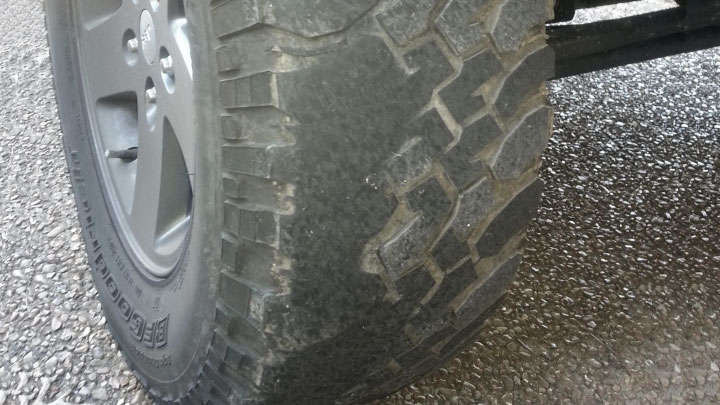
Cupped tires tend to make a rather loud humming or droning noise when traveling down the road. In many ways, it’s comparable to the sound of a bad wheel bearing.
However, in the case of cupped tires, this sound does not change significantly when steering in one particular direction or the other. Of additional note, this sound tends to be much more pronounced in the case of cupped all-terrain or mud tires.
As tire cupping progresses, this sound will only continue to become more pronounced, eventually becoming extremely noticeable in nature. Unfortunately, the only way to alleviate this noise is by replacing your vehicle’s irregularly worn tires.
Can a Cupped Tire Be Fixed?
Whether or not cupped tires can be fixed is largely a case-by-case matter. If caught early enough, cupping can be minimized by properly balancing and rotating a vehicle’s tires, thereby placing each affected tire at a different wheel-end location.
Additionally, the exact cause of your tires’ cupping should be diagnosed and repaired as soon as possible. Doing so prevents your newly rotated tires from suffering the same wear.
However, some tires might be beyond the point of salvage. This is the case when cupping has occurred over a lengthy period of time, causing large discrepancies in tread wear.
In cases such as this, it is often best to start fresh with the installation of new tires, following the repair of any underlying mechanical issues.
Tire Cupping vs Feathering

The terms “cupping” and “feathering” are often used interchangeably when describing irregular tire wear. However, these two conditions are not one and the same.
Cupping describes an obvious dishing or scalloping of a tire’s tread, while feathering refers to a slanted wear pattern of individual tread blocks.
The latter of these conditions causes a tire’s tread to be worn considerably more on one edge of a tread block, while the other edge of a particular block of tread will be prominent and upturned. This creates a stair-stepped pattern across a tire’s tread, often resulting from alignment-related issues.
Prevention
Tire cupping is perhaps best prevented through regular, proactive vehicle maintenance. This includes regularly having your vehicle’s tires rotated and balanced, in addition to having an alignment performed any time that your vehicle’s tires are replaced.
These steps alone will greatly reduce the prominence of irregular tire wear as a whole, including cupping.
It is also advised to have your vehicle’s steering and suspension components inspected by a trained professional, at regular intervals. All components found to be defective, damaged, or excessively worn should be replaced.
This, in turn, prevents unnecessary damage from being done to a vehicle’s tires, thereby saving motorists both time and money.
- P0480 Code (Symptoms, Causes, and How to Fix) - Apr 19, 2024
- Car Temperature Gauge Stopped Working? (Here’s Why) - Apr 15, 2024
- Ignition Coil vs Coil Pack (What’s the Difference?) - Apr 8, 2024
